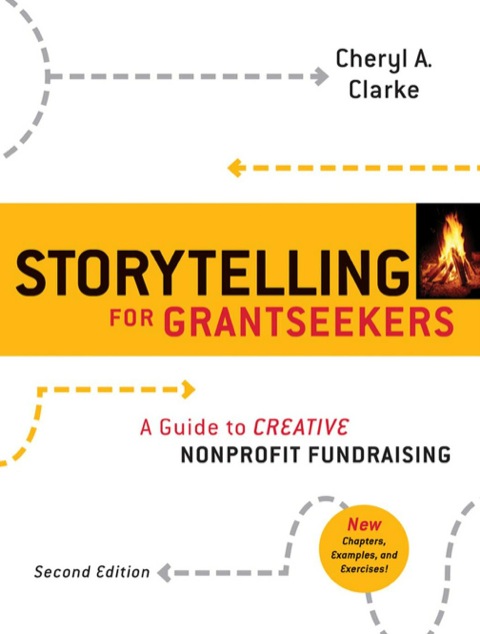Description
Efnisyfirlit
- Contents
- Examples
- Foreword
- Preface
- Acknowledgments
- The Author
- Introduction: Why Storytelling?
- What is the Storytelling Method?
- You are Already a Storyteller
- Chapter One: First Steps: Getting Ready for Grantseeking
- Get Prepared
- Is The Project Fundable?
- Don’t Let a Bad Proposal Disguise a Good Idea
- Is Your Story Ready to Be Told?
- Know What You’re Raising Money For
- Get Ready to Tell Your Story
- Be a Reporter
- Be a Researcher
- “Talk” Your Story
- Summary
- Chapter Two: Research and Relationships: Finding and Cultivating Your Audience
- Efficient Research: The Four Filters Plus One
- The Four Filters Plus One-Up Close
- Subject Area
- Geographic Preference
- Type of Financial Need
- Dollar Range of Grants
- Relationships: The Plus – One Filter
- How Much Money to Request
- How Long Your Grantmaker List Should Be
- How to Find the Grantmakers
- The Foundation Center Libraries
- The Internet
- Nonprofit Agencies Doing Similar Work
- Publications and Other Media
- Your Professional Network
- Recruiting Others to Help You
- What to Do With Your “Short List” of Grantmakers
- Cultivating an Audience
- Using Connections
- Busting A Popular Myth
- Summary
- Chapter Three: The Short Story: Writing Letters of Inquiry
- Purpose of the Letter of Inquiry
- The Key Word is Fit
- How to Craft a Letter of Inquiry
- Summary
- Chapter Four: The Proposal Narrative: Introducing the Characters and the Place
- Open With a “Hook”
- Present Fundamental Information
- Introduce the Hero
- How Long Should the Introduction Be?
- Establishing Credibility for a Start – Up Agency
- Introducing the Hero: Examples
- Advice About Mission Statements
- Introduce the Other Main Characters
- Writing About the Other Main Characters
- Writing About Main Characters Other Than People
- Establish a Sense of Time and Place
- Creating a Sense of Time
- Creating a Sense of Place
- Summary
- Chapter Five: The Need or Problem: Building Tension and Confl ict into Your Story
- Understanding the Story ARC
- Who is the Antagonist?
- How Long Should the Needs Section Be?
- Applying the Storytelling Method
- Presenting the Antagonist
- Telling the Back Story
- Joining Forces With Other Heroic Agencies
- Using Data and Statistics Effectively
- Citing Sources, Using Footnotes, and Checking Facts
- Putting a Human Face on the Problem
- Giving the Lead Characters a Voice
- Whose Need is it Anyway?
- Pulling it All Together
- Summary
- Chapter Six: Goals, Objectives, and Methods: Making Changes by Addressing the Problem
- The Goals and Objectives Section
- The Difference Between Goals and Objectives
- Your Agency as Hero, Not Superhero: Keeping Objectives Realistic
- Length and Format of the Goals and Objectives Section
- The Methods Section
- How Much Detail to Include in the Methods Section
- Tips About Timelines and Bulleted Lists
- Program Promises
- Summary
- Chapter Seven: Evaluation and Future Funding: Writing the Epilogue and Planning for a Sequel
- The Epilogue and Why It’s Important
- Evaluation Tools, Strategies, and Reports
- How to Write a Compelling Evaluation Section
- The Sequel and Why It’s Important
- Why You Need a Future Funding Plan
- The Future Funding Section
- Summary
- Chapter Eight: The Budget: Translating Your Story from Words to Numbers
- Who Translates the Narrative to Numbers?
- What the Budget Is
- How to Budget for Continuing Programs
- How to Budget for New Programs
- A Note About Budget Notes
- Expected Revenues: More Detail
- Expected Expenses: More Detail
- Other Costs That Can Be Allocated in a Program Budget
- Take Only One Bite of the Apple
- Including In – Kind Contributions
- Cash Flow Analysis
- Financial Statements
- Summary
- Chapter Nine: The Summary, Titles, and Headings: Preparing Your Marketing Copy
- Why the Summary is Like a Book Jacket
- Write the Summary After the Proposal
- The Summary’s Significance
- What the Summary Means to Grantmakers: An Insider’s View
- Persuasive Titles and Headings: A Few Carefully Chosen Words
- Program Titles
- Section Headings
- Summary
- Chapter Ten: Packaging: Publishing Your Proposal Story
- No Boilerplate Proposals
- Applying Online
- All Dressed Up and Someplace to Go: The Packaging of a Paper Submission
- White Bond Paper
- Ample Margins
- Adequate Type Size
- Single Spacing
- No Binders!
- An Escort for the Proposal: The Cover Letter
- Accompanying Documents
- Mandatory Traveling Companions
- Optional or Occasional Traveling Companions
- Delivery of the Proposal
- Repackaging Your Proposal: The Letter Format
- Summary
- Chapter Eleven: Site Visits and Beyond: Interacting with Funders
- How to Stage a Site Visit
- Communicating with Funders
- What to Do When the Funder Says No
- What to Do When the Funder Says Yes
- Beyond the Grant Award
- Summary
- Chapter Twelve: Beyond Grants: Applying the Storytelling Method
- Elevator Speech
- Mission Statement
- Case Statement
- Appeal Letters
- Brochures
- Web Site Content
- Annual Reports
- Government Grants and Storytelling?
- Beyond Nonprofits
- Afterword
- Appendix: The Final Manuscript: Two Letter Proposal Samples
- Index
- End User License Agreement







Reviews
There are no reviews yet.